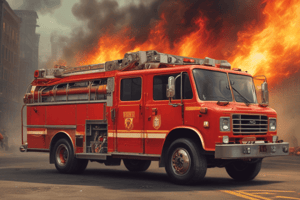Podcast
Questions and Answers
What type of fire occurs when a cigarette butt is thrown in an area with large amounts of flammable materials?
What type of fire occurs when a cigarette butt is thrown in an area with large amounts of flammable materials?
- Class A fire (correct)
- Class B fire
- Pyrotechnic-related fire
- Class C fire
What is a common cause of fires involving electrical appliances?
What is a common cause of fires involving electrical appliances?
- Improper handling and storage
- Using them near water
- Malfunctioning or improperly used (correct)
- Neglecting to turn them off when not in use
Which of the following is a fire hazard?
Which of the following is a fire hazard?
- Properly stored chemicals
- Fully extinguished candles
- Improperly used matchsticks or lighters (correct)
- Electrical appliances in good condition
What type of fire involves energized electrical compounds?
What type of fire involves energized electrical compounds?
What is a precaution to prevent fires involving chemicals?
What is a precaution to prevent fires involving chemicals?
What is a common cause of fires involving candles or gas lamps?
What is a common cause of fires involving candles or gas lamps?
What type of fire involves combustible metals such as potassium, sodium, and aluminum?
What type of fire involves combustible metals such as potassium, sodium, and aluminum?
What is the primary cause of fire incidents in the Philippines, according to the Bureau of Fire Protection (BFP) in 2013?
What is the primary cause of fire incidents in the Philippines, according to the Bureau of Fire Protection (BFP) in 2013?
What is the purpose of a fire risk assessment?
What is the purpose of a fire risk assessment?
What is the benefit of installing a fire alarm system?
What is the benefit of installing a fire alarm system?
What is the purpose of a fire blanket?
What is the purpose of a fire blanket?
What type of fire involves combustible household liquids such as cooking oil and grease?
What type of fire involves combustible household liquids such as cooking oil and grease?
What type of fuel has a definite size and shape?
What type of fuel has a definite size and shape?
What is the process by which liquid fuels generate flammable vapors?
What is the process by which liquid fuels generate flammable vapors?
Why are gas fuels considered the most dangerous type of fuel?
Why are gas fuels considered the most dangerous type of fuel?
What is a common cause of fire hazards?
What is a common cause of fire hazards?
What is an example of a non-combustible material?
What is an example of a non-combustible material?
What is a potential fire hazard related to LPG?
What is a potential fire hazard related to LPG?
Flashcards are hidden until you start studying
Study Notes
Common Causes of Fire
- Electrical appliances can catch fire if improperly handled or used, or when used while malfunctioning
- Cigarette butts can be dangerous when thrown over areas with large amounts of flammable materials
- Neglected candles or gas lamps can cause fires when left near combustible materials
- Improper use of matchsticks or lighters, especially by children, can accidentally cause fire disasters
- Chemicals can be highly flammable if not stored and handled properly, leading to fires
- Pyrotechnic-related fires can be caused by improper handling and storage of fireworks
- Malfunctioning fireworks can also cause unwanted fires
- Lightning can cause fires when it hits a flammable object on the surface of the Earth
Fire Classification
- Class A: ordinary combustible materials that leave ash, such as paper, wood, plastic, rubber, cloth, and trash
- Class B: combustible chemicals of liquid and gas, such as petroleum oil, gasoline, paint, propane, and butane
- Class C: energized electrical compounds, such as electrical appliances, motor equipment, and machines
- Class D: combustible metals, such as potassium, sodium, aluminum, magnesium, and titanium
- Class K: combustible household liquids, such as cooking oil, animal fat, and grease
Precautionary Measures and Response
- Fire risk assessment is a means to understand the situation of an area and determine the different preventive measures needed to reduce the vulnerability of an area against fire
- Installing a fire alarm system can help in being aware of a fire before it gets big and uncontrollable
- Buying a fire extinguisher and a fire blanket is important in preventing a fire outbreak from becoming uncontrollable
Fire Fuels
- Not all materials can become fuel for a fire
- Solid fuels have definite size and shape, such as wood, paper, leather, grain, cork, coal, cloth, and plastic
- Liquid fuels generate flammable and combustible vapors through vaporization, such as gasoline, kerosene, turpentine, lacquer-paint, varnish-alcohol, and olive oil
- Gas fuels are the most dangerous of all fuel types, requiring less energy for ignition, such as acetylene, hydrogen, propane, carbon monoxide, and methane
Studying That Suits You
Use AI to generate personalized quizzes and flashcards to suit your learning preferences.



